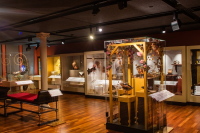
Margaux Warne
‘Fantastic Feasts’ is the latest exhibition at the Teece Museum and is a must-see interdisciplinary exhibition for anyone interested in ancient history, art history and classical mythology. Meticulously researched and carefully curated, ‘Fantastic Feasts’ focuses on the everyday eating habits and traditions of the ancient Greeks and Romans. It features a number of remarkable drinking vessels and other unique artefacts from the James Logie Memorial Collection and several other public and private collections
Through the objects on display and the informative text panels that accompany them, the exhibition explores the variety of foods that were prepared and consumed by the Greeks and Romans and how food was a symbol of social status and a way in which families and communities came together. The exhibition also delves into the food preparation and cooking practices of these two cultures, as well as their unique celebrations and rituals involving eating and drinking. Also of importance are the relationships that existed between food and sacrifice and how ancestors and the gods were honoured through food and libation.
A focus has been placed on the Greek symposium and on display are several vessels intended for these notorious and highly intriguing drinking parties. Of significance is an impressive black-figure column-krater, ca. 530-520 BCE. The krater was used for the mixing of wine and water and this particular one portrays Heracles completing the first of his famous Twelve Labours by wrestling the Nemean lion. Heracles is also depicted on an Athenian black-figure band-cup, ca. 540-530 BCE. Another highlight is an Athenian red-figure kylix, ca. 480 BCE. The kylix was a wine cup also used at symposiums and this one depicts a symposiast reclining on a couch and holding a cup of wine.
Other noteworthy objects include a pair of Greek parcel gilt silver emblemata dating from around the 3rd century BCE. Ornate silver reliefs such as these would have decorated the interiors of dishes used in feasts. A personal favourite is the quaint Apulian red-figure oinochoe, ca. 330-320 BCE. This lidded wine jug features Eros, the Greek god of love, and is elaborate in design and detail.
Pitched at just the right level to cater for the variety of visitors to the Teece Museum, ‘Fantastic Feasts’ illustrates how food and eating have always been essential to the rituals of our daily lives and celebrations.
Fantastic Feasts: Food of the Ancient Greeks and Romans
Curated by Terri Elder and Alice English
Teece Museum of Classical Antiquities, the Arts Centre of Christchurch, 3 Hereford Street
IMAGE
JLMC215.14 Apulian red-figure oinochoe. Copyright UC. Photographer: Duncan Shaw-Brown.
11 April - 23 February 2020
